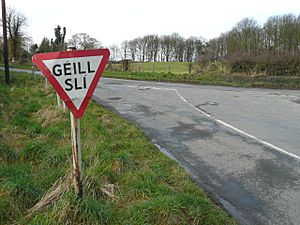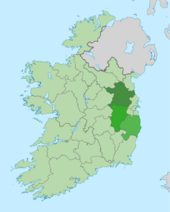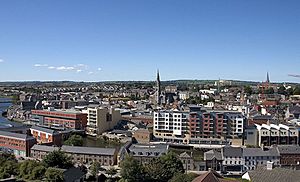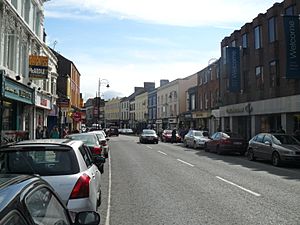Mid-East Region, Ireland facts for kids
The Mid-East Region is a special area in Ireland. It's like a group of counties put together for statistics and planning. This region includes the counties of Kildare, Louth, Meath, and Wicklow.
The Mid-East covers a large area of 6,891 square kilometers. That's about 9.8% of Ireland's total land. In 2022, over 764,000 people lived here, which is nearly 15% of Ireland's population.
This region has been growing steadily since 1961. Many people move here because it's close to Dublin, Ireland's capital city. While it has big towns, much of the Mid-East is beautiful countryside with lots of farms. It's also home to high-tech companies in places like Leixlip and Bray.
You can find many cool places to visit in the Mid-East. These include Trim Castle, Kildare Cathedral, the ancient site of Brú na Bóinne, and the stunning Glendalough. Important natural spots are the River Liffey, the Wicklow Mountains, and the Curragh of Kildare, famous for horse breeding.
Contents
How the Region is Managed
From 1994 to 2014, the Mid-East Region was looked after by the Mid-East Regional Authority. This group had 21 people who were chosen to represent the area. They met once a month to make decisions.
These representatives came from the local councils of:
In 2015, these regional authorities changed. Now, the Mid-East is part of the Eastern and Midland Regional Assembly. This assembly helps plan for the future of the region.
Counties in the Mid-East
The Mid-East Region includes four counties. These are the local government areas that make up the region:
In 2018, there was a change to how regions were grouped. County Louth used to be in the Border Region. But because Louth is very connected to the Greater Dublin Area and has strong economic links, it was moved to the Mid-East Region. This meant the Mid-East grew from three counties to four.
Even though Louth is the smallest county in the Mid-East by population, it has the region's two biggest towns: Drogheda and Dundalk. These are also among the largest towns in all of Ireland! With Louth joining, the Mid-East Region now also shares a border with Northern Ireland.
People and Population

The Mid-East is one of the fastest-growing regions in Ireland. All four counties here are seeing their populations increase much faster than the national average. The area around Dublin, including Meath, Kildare, and Wicklow, is called the Greater Dublin Area. About 40% of Ireland's population lives here. When you combine Dublin and the Mid-East, over 2 million people live in this larger area.
The 2022 census showed that the Mid-East had a population of 764,154. This means there are about 100 people living in every square kilometer, making it the second most crowded region in Ireland.
Kildare has the most people in the Mid-East. Meath is the largest county by land area. Louth is the smallest county in the region, both in terms of people and size.
Irish Language Areas
The Mid-East is home to Leinster's only Gaeltacht areas. These are places where the Irish language is the main language spoken. They are both in County Meath, in areas called Ráth Chairn and Baile Ghib. These Gaeltachts were started by people who moved from County Galway in the 1930s.
They are the two smallest Gaeltachts in Ireland, with about 1,771 native Irish speakers. In 2016, about 40% of people in Kildare spoke Irish, 38% in Meath, 36% in Wicklow, and 34% in Louth. Louth has the lowest percentage of Irish speakers of any county in Ireland.
Major Towns
The Mid-East has many large towns. There are 27 towns with more than 5,000 people. Out of these, 17 towns have over 10,000 people.
Here are the ten largest towns in the Mid-East Region:
| Rank | Town | County | Population (2022 census) |
|---|---|---|---|
| 1 | Drogheda | Louth & Meath | 44,135 |
| 2 | Dundalk | Louth | 43,112 |
| 3 | Navan | Meath | 33,886 |
| 4 | Bray | Wicklow & Dublin | 33,512 |
| 5 | Naas | Kildare | 26,180 |
| 6 | Newbridge | Kildare | 24,366 |
| 7 | Greystones-Delgany | Wicklow | 22,009 |
| 8 | Celbridge | Kildare | 20,601 |
| 9 | Maynooth | Kildare | 17,259 |
| 10 | Leixlip | Kildare | 16,733 |
Economy and Jobs
The Mid-East Region has a strong economy. In 2012, the total value of all goods and services produced in the region was about €13.3 billion. This is known as the Gross Domestic Product (GDP).
The unemployment rate in the Mid-East was very low in 2016, at just 5.3%. This was the lowest rate compared to other regions in Ireland, meaning many people had jobs. The manufacturing industry and high-tech companies provide a lot of jobs in the area.





